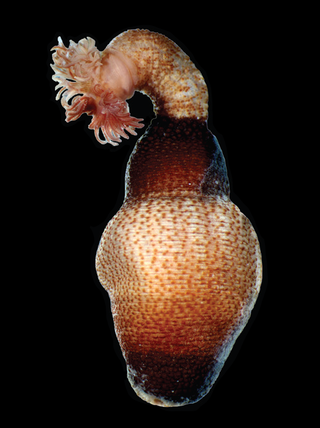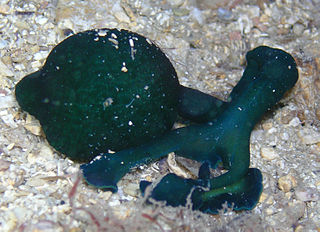Related Research Articles

Bryozoa are a phylum of simple, aquatic invertebrate animals, nearly all living in sedentary colonies. Typically about 0.5 millimetres long, they have a special feeding structure called a lophophore, a "crown" of tentacles used for filter feeding. Most marine bryozoans live in tropical waters, but a few are found in oceanic trenches and polar waters. The bryozoans are classified as the marine bryozoans (Stenolaemata), freshwater bryozoans (Phylactolaemata), and mostly-marine bryozoans (Gymnolaemata), a few members of which prefer brackish water. 5,869 living species are known. At least two genera are solitary ; the rest are colonial.

The Sipuncula or Sipunculida is a class containing about 162 species of unsegmented marine annelid worms. The name Sipuncula is from the genus name Sipunculus, and comes from the Latin siphunculus meaning a "small tube".

Nemertea is a phylum of animals also known as ribbon worms or proboscis worms, consisting of 1300 known species. Most ribbon worms are very slim, usually only a few millimeters wide, although a few have relatively short but wide bodies. Many have patterns of yellow, orange, red and green coloration. The foregut, stomach and intestine run a little below the midline of the body, the anus is at the tip of the tail, and the mouth is under the front. A little above the gut is the rhynchocoel, a cavity which mostly runs above the midline and ends a little short of the rear of the body. All species have a proboscis which lies in the rhynchocoel when inactive but everts to emerge just above the mouth to capture the animal's prey with venom. A highly extensible muscle in the back of the rhynchocoel pulls the proboscis in when an attack ends. A few species with stubby bodies filter feed and have suckers at the front and back ends, with which they attach to a host.

Anthozoa is a class of marine invertebrates which includes the sea anemones, stony corals and soft corals. Adult anthozoans are almost all attached to the seabed, while their larvae can disperse as part of the plankton. The basic unit of the adult is the polyp; this consists of a cylindrical column topped by a disc with a central mouth surrounded by tentacles. Sea anemones are mostly solitary, but the majority of corals are colonial, being formed by the budding of new polyps from an original, founding individual. Colonies are strengthened by calcium carbonate and other materials and take various massive, plate-like, bushy or leafy forms.

Phoronids are a small phylum of marine animals that filter-feed with a lophophore, and build upright tubes of chitin to support and protect their soft bodies. They live in most of the oceans and seas, including the Arctic Ocean but excluding the Antarctic Ocean, and between the intertidal zone and about 400 meters down. Most adult phoronids are 2 cm long and about 1.5 mm wide, although the largest are 50 cm long.
Golfingia vulgaris is a marine invertebrate belonging to the phylum Sipuncula, the peanut worms. It is a cylindrical, unsegmented worm with a crown of tentacles around the mouth. It lives in burrows in shallow seas in various parts of the world.

Aspidosiphonidae is a family of peanut worms. It is the only family in the monotypic order Aspidosiphonida, which is in the class Phascolosomatidea.

Golfingiidae is a family of peanut worms.

Golfingiida, also known as the Golfingiiformes, is an order of peanut worms. The tentacles form a circle around the mouth, while those of the sister taxon, Phascolosomatidea, are only found above the mouth. Most species burrow in the substrate but some live in the empty shells of gastropods. It is an order of the class Sipuncula, and contains the following families:
Phascolionidae is a family of peanut worms.

Nephtheidae is a family of soft corals in the phylum Cnidaria. Members of this family are known as carnation corals, tree corals or colt soft corals. They are very attractive and show a wide range of rich and pastel colours including reds, pinks, yellows and purples. They are popular with reef aquarium hobbyists.

Antillesoma is a genus of peanut worms. The genus belongs to the family Phascolosomatidae. Antillesoma was described in 1973 by Stephen and Edmonds.

The annelids, also known as the segmented worms, are a large phylum, with over 22,000 extant species including ragworms, earthworms, and leeches. The species exist in and have adapted to various ecologies – some in marine environments as distinct as tidal zones and hydrothermal vents, others in fresh water, and yet others in moist terrestrial environments.
Nephasoma minutum is a marine invertebrate of the phylum Sipuncula, commonly known as peanut worms because of their shape when contracted. It is a cylindrical, unsegmented worm with a crown of tentacles around the mouth. These worms live in crevices in the rocks or in burrows in shallow water in Western Europe, and the eastern United States.
Nephasoma rimicola is a marine invertebrate belonging to the phylum Sipuncula, the peanut worms. This worm occurs in the northeastern Atlantic Ocean.

Bonelliidae is a family of marine worms noted for being sexually dimorphic, with males being tiny in comparison with the females. They occupy burrows in the seabed in many parts of the world's oceans, often at great depths.
Aspidosiphon elegans is a species of unsegmented benthic marine worm in the phylum Sipuncula, the peanut worms. It is a bioeroding species and burrows into limestone rocks, stones and corals. It occurs in the western Indo-Pacific region, the Red Sea, and the tropical western Atlantic Ocean, and is invasive in the eastern Mediterranean Sea.
Themiste cymodoceae is a species of unsegmented benthic marine worm in the phylum Sipuncula, the peanut worms. It is native to shallow waters around Australia and in the South China Sea where it lives in a cavity it creates among seagrass roots and in empty oyster shells.

Themiste pyroides is a species of unsegmented benthic marine worm in the phylum Sipuncula, the peanut worms. It occurs in the intertidal zone and shallow water in the western Atlantic Ocean and the northeastern Pacific Ocean. It lives in crevices and under rocks, extending its "crown" of branching tentacles into the surrounding water to feed.
Thysanocardia procera is a marine invertebrate belonging to the phylum Sipuncula, the peanut worms. It is a cylindrical, unsegmented worm with a crown of tentacles around the mouth. It is native to shallow seas in the northeastern Atlantic Ocean.
References
- ↑ Stephen, A. C., and. Edmonds S. J. (1972): The Phyla Sipuncula and Echiura. vii+528 Trustees of The British Museum of Natural History. London. ISBN 0-565-00717-3
- ↑ Ditadi, A.S.F. & Migotto, A.E. (1982): O Filo Sipuncula. Concelho Nacional de Desemvolvimento Cientifico e Tecnologico CNPq Brasilia. 43p.
- 1 2 3 4 5 6 Cutler, Edward B. & Cutler, Norma J (1985): A revision of the genera Phascolion Théel and Onchnesoma Koren and Danielssen (Sipuncula). Proceedings of Biological Society of Washington 94(4):809-850
- ↑ Cutler, Edward B. & Gibbs, Peter E. (1985): A Phylogenetic analysis of higher taxa in the Phylum Sipuncula. Systematic Zoology 34(2):162-173.
- 1 2 3 4 5 6 Cutler, Edward B. (1994): The Sipuncula: their systematic, biology and evolution. Comstock Publishing Associates of Cornell University. Ithaca, New York. 406p ISBN 0-8014-2843-2 Google Books
- ↑ Cutler, Edward B. (1973): Sipuncula of the Western North Atlantic. Bulletin of American Museum of Natural History, 152(3):103-203.
- ↑ Gibbs, Peter E and Cutler, Edward B. (1987): A classification of the phylum Sipuncula. Bulletin of the British Museum (Natural History) Zoology, 52(1):43-58
- ↑ Murina, V.V. (1976): New and rare species of sipunculida from the East China Sea. Vestnik Zoologi, 2:62-67
- ↑ Cutler, Edward B. (1969): New species of Sipuncula from western North Atlantic. Proceedings of Biological Society of Washington, 82:209-218.
- ↑ Smithsonian National Museum of Natural History. Antarctic Invertebrates: Onchnesoma magnibathum Cutler, 1969 http://invertebrates.si.edu/antiz/taxon_view.cfm?ScreenWidth=1003&ScreenHeight=567&taxon=8585&MODE=taxon
- 1 2 Koren, J. and Danielssen, D.C. (1875): Bidrag de norskr Gephyreens Naturhistorie. Nytt. Magasin for Naturvidenskapene, 21:201-138.